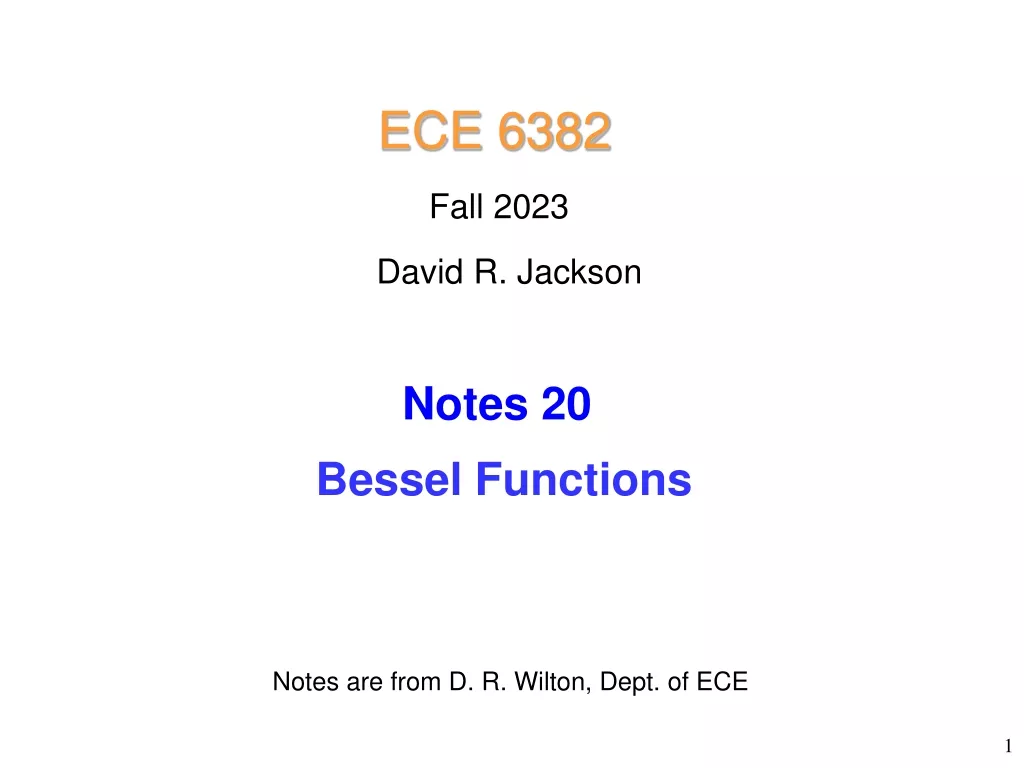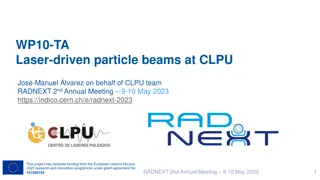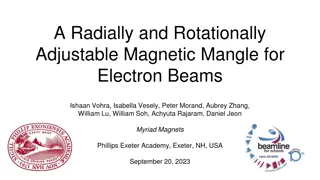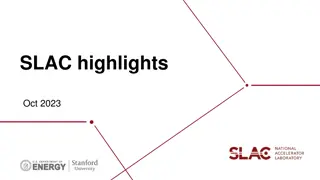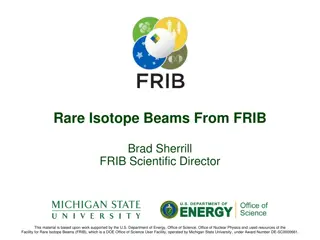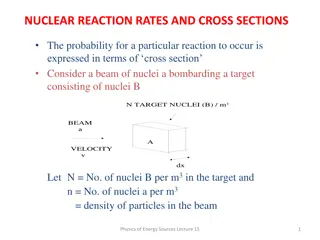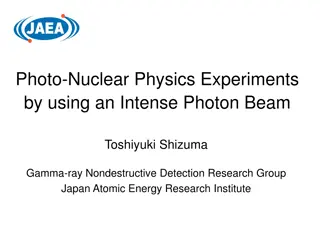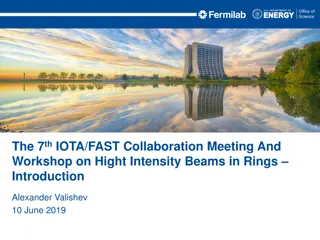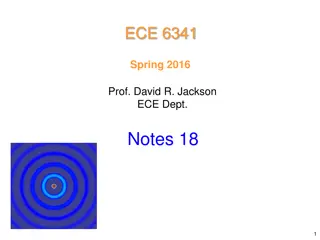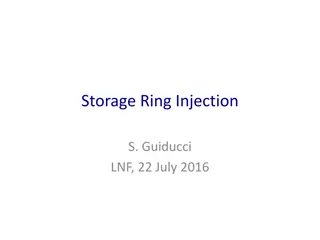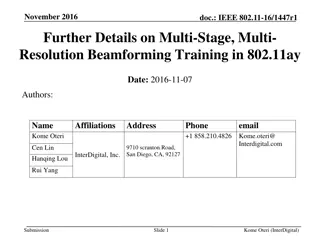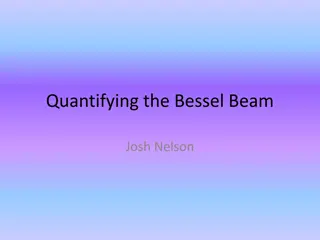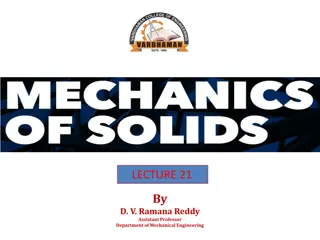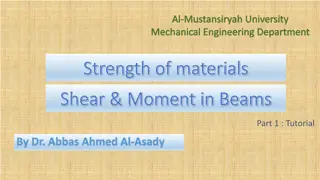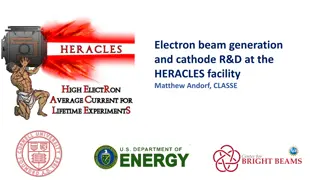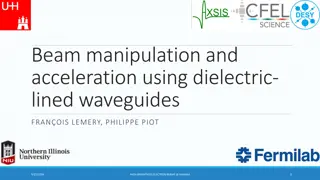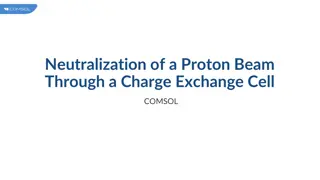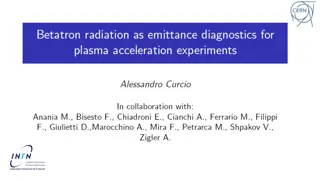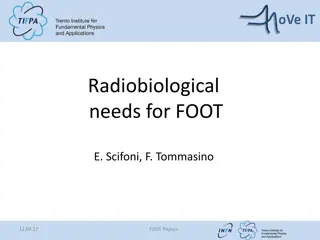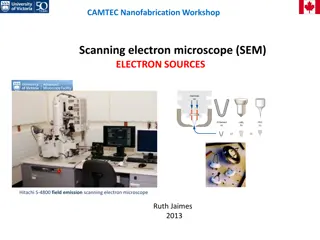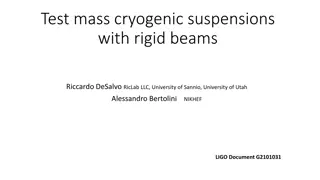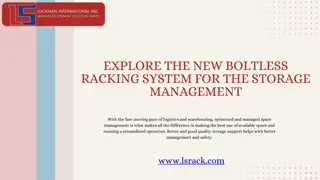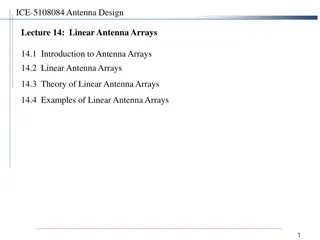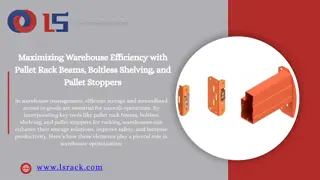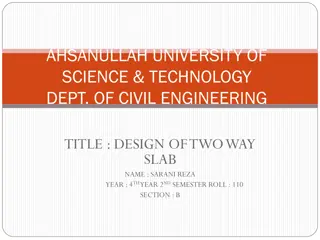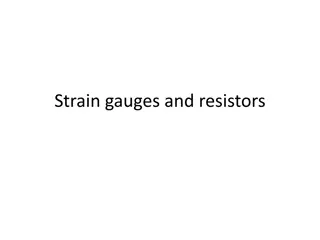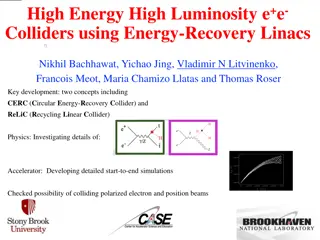FPC & HOM Technology Challenges, FCC
The challenges and technology involved in coupling beam power out of the cavity and coupling RF power into the cavity for the Future Circular Collider (FCC). It also covers the RF layout for the FCC-ee, basic parameters for proton and electron beams, accelerating RF in the LHC, input couplers, and p
0 views • 36 slides
NEC Metropole Hilton Birmingham Lighting Production
Calibar recently provided the production for a high profile Indian Wedding at the prestigious NEC Metropole Hilton Hotel and transformed the venue into an amazing spectacle.\n\n \n\nOur production team took over the whole ceiling across the impressive Monarch suite and using a mixture of LED washers
3 views • 3 slides
Cylindrical Wave Functions and Bessel Equations in Electromagnetics
Exploring cylindrical wave functions and Bessel equations, derived from the Helmholz equation, for understanding wave propagation dynamics in electromagnetics. The notes cover separation of variables, solutions for R and Z, Bessel functions, and more.
4 views • 50 slides
ECFA Detector R&D Roadmap and International Collaborations Update
The ECFA Detector R&D Roadmap outlines collaborative efforts in particle physics research, focusing on high-field magnets, muon beams, and more. Task Forces are coordinating community consultations for future experimental programs, with a goal to fulfill strategic needs identified by the ESPP update
1 views • 28 slides
High-Energy Recycling in E+ E- Colliders: Energy Recovery Linacs (ERLs) Advancements
High-energy recycling in E+ E- colliders involves the innovative concept of Energy Recovery Linacs (ERLs), pioneered by experts like Vladimir N. Litvinenko. These ERLs effectively recycle energy from collided beams, reducing energy consumption and increasing collider efficiency by maximizing luminos
1 views • 21 slides
Laser-Driven Particle Beams at CLPU: Insights from the RADNEXT 2nd Annual Meeting
Delve into the world of laser-driven particle beams at CLPU as discussed in the RADNEXT 2nd Annual Meeting. Explore topics like high-intensity laser facilities, laser plasma accelerator applications, and the innovative use of Laser VEGA for transnational access. Witness the evolution of laser physic
2 views • 29 slides
A Radially and Rotationally Adjustable Magnetic Mangle for Electron Beams
The project introduces a radially and rotationally adjustable magnetic mangle designed by a diverse team from different locations. The motivation behind the experiment is to test the viability of an adjustable magnetic mangle as an alternative to traditional electromagnets in accelerators. The uniqu
3 views • 17 slides
BASIC STRUCTURAL CONSIDERATIONS.
Bridge members must support various loads and stresses. This presentation covers how loads are applied, how members are stressed, and how materials resist stress. It discusses different member types like beams/girders, simple beams, continuous beams, and columns/hangers. Stresses such as tension, co
0 views • 34 slides
Latest Achievements at SLAC - October 2023
SLAC has achieved significant milestones including first light from the SXR and HXR undulators, advancements in accelerator technology, and notable performance metrics for their FEL systems. Special thanks were extended to the LCLS-II collaboration for their hard work. The high repetition rate at LC
2 views • 19 slides
Rare Isotope Beams from FRIB - Facility Overview and Operations
FRIB (Facility for Rare Isotope Beams) is supported by the U.S. Department of Energy and Michigan State University. It utilizes advanced techniques for rare isotope beam formation, offering insights into nuclear physics. The facility operates with high beam power, serving various scientific experime
0 views • 15 slides
Trauma and Healing: Insights from Neuroscience
Recent neuroscience findings based on the work of Professor Bessel van der Kolk shed light on how trauma affects the human organism. Traumatic experiences leave lasting legacies on individuals, families, and societies, impacting mental, emotional, and physical well-being. The profound changes trauma
1 views • 32 slides
Nuclear Reaction Rates and Cross Sections
Nuclear reaction rates and cross sections play a crucial role in determining the probability of interactions between particle beams and target nuclei. Cross section is the effective area of a target nucleon to the incident beam, with the interaction probability calculated based on the number density
1 views • 13 slides
Advanced Photon-Beam Experiments in Nuclear Physics Research
Explore cutting-edge experiments in nuclear physics using intense photon beams, nondestructive isotope detection, laser Compton scattering rays, and photon beams for fundamental collective motion studies. Learn about nuclear resonance fluorescence, dipole excitation strength distribution, and detail
0 views • 12 slides
Combined Effect of Charged Particles Irradiation and Anticancer Drugs in Cultured Human Tumor Cells
Research collaboration aimed to enhance locoregional tumor control and reduce distant failure by combining charged particles irradiation and anticancer drug Epothilone B in cultured human tumor cells from Milano and Roma. The study explores the impact on clonogenic survival, growth curves, and deter
0 views • 13 slides
7th IOTA/FAST Collaboration Meeting & Workshop on High-Intensity Beams
The 7th IOTA/FAST Collaboration Meeting & Workshop on High-Intensity Beams in Rings, led by Alexander Valishev, featured discussions, emergency procedures, logistics, and a structured meeting agenda focusing on experimentation, research, and future opportunities.
0 views • 4 slides
Cryogenic Gas Stopping Cell for High Precision Nuclear Physics Experiments
In the field of nuclear physics, high-quality ion beam parameters are essential for both primary and secondary beams. This report focuses on the cryogenic gas stopping cell, also known as a gas catcher, designed to transform rare ion beams from nuclear reactions into low-energy beams with small emit
1 views • 12 slides
Electromagnetic Scattering by Wedge and Line Source Notes
In these notes from ECE 6341, Spring 2016, Prof. David R. Jackson covers the topic of scattering by a wedge and line source. The discussion includes boundary conditions, Bessel functions, integration techniques, and more, providing a thorough exploration of the electromagnetic phenomena involved.
0 views • 27 slides
Injection Process in Particle Accelerators
The injection process in particle accelerators involves transferring beams efficiently with minimal loss and emittance dilution. It includes on-axis injection onto the reference orbit using septum magnets and fast kickers to maintain beam trajectory accuracy. The design aims to achieve precise beam
0 views • 22 slides
Optical Frequency Interferometer Bench Analysis
Detailed examination of the optical setup for an Optical Frequency Interferometer (OFI) system, including the input/output configurations with various optical components such as prisms, crystals, and wave plates. The analysis focuses on the path and behavior of beams within the system, considering r
0 views • 14 slides
Enhancements in Multi-Stage Beamforming Training for IEEE 802.11ay
IEEE 802.11ay introduces improvements in beamforming training procedures for efficiency and MIMO support. The multi-stage, multi-resolution beamforming training framework enhances beamforming efficiency with high-resolution beams. The proposal includes a Sector Sweep frame and support for up to 2048
0 views • 19 slides
Quantifying Bessel Beams in Fiber Optics
To analyze Bessel beams in fiber optics, a fitting algorithm must be coded to quantify the beam. The process involves defining combinations of Bessel functions, finding the best fit through iterations, and addressing the substantial computational challenge posed by the large number of calculations.
0 views • 13 slides
Sectional Modulus and Bending Stress in Beams
Explore the concept of sectional modulus in beams and how it relates to bending stress. Learn about calculating maximum stress, moment of inertia, and solving bending stress problems in various beam sections. Dive into case studies to apply these principles practically.
0 views • 27 slides
Shear and Moment in Beams
Beams play a crucial role in mechanical engineering, with two main types - statically determinate and indeterminate beams. Explore the definition of beams, loading types, and the concept of shear and moment diagrams to understand the behavior of beams under different loads and reactions. Learn how t
0 views • 8 slides
Electron Beam Generation and Cathode Research at HERACLES Facility
Research at the HERACLES facility focuses on electron beam generation and cathode development for high-current applications. Photocathodes play a crucial role in providing low energy spread beams required for processes like FEL-lasing. GaAs emerges as a promising candidate for spin-polarized electro
0 views • 33 slides
Achieving High Average Beam Polarization in Particle Colliders
Detailed discussion on achieving high average beam polarization in particle colliders like CEPC, focusing on longitudinal polarized colliding beams, beam polarization requirements, basic formulas, and strategies for maintaining beam polarization during physics runs. Emphasis on scenarios involving s
2 views • 16 slides
High Brightness Electron Beams: Beam Manipulation and Acceleration Using Dielectric-Lined Waveguides
This presentation discusses the manipulation and acceleration of electron beams through the use of dielectric-lined waveguides. It delves into motivations for accelerators, beam-driven acceleration, wakefields, transformer ratio, and the search for continuous smooth shapes in beam technologies. Vari
2 views • 30 slides
Neutralization of Proton Beam Using Charge Exchange Cell in COMSOL
In various applications, collisions of neutral particle beams with target materials play a crucial role. This process involves neutralizing high-velocity proton beams by passing them through a charge exchange cell filled with neutral gas, such as argon. The cell allows protons to capture electrons f
0 views • 17 slides
Plasma Acceleration and Betatron Oscillations Beam Characterization Method
The method for evaluating the quality of beams accelerated through plasma acceleration and betatron oscillations involves non-intercepting diagnostics to infer information about the electrons while inside the accelerating structure. It includes measuring the rms emittance and correcting the betatron
0 views • 12 slides
Advancements in Biological Treatment Planning for Ion Beams
Exploring the integration of biological effect information in treatment planning for ion beams, this collection of research discusses the importance of proper data accounting for enhanced patient-specific planning and beam selection. Topics include radiobiological needs, target and projectile fragme
0 views • 18 slides
Scanning Electron Microscopes (SEM) and Electron Sources
Scanning Electron Microscopes (SEMs) utilize focused electron beams to produce high-resolution images by interacting with a sample's electrons. The electron source, such as the electron gun, plays a crucial role in forming fine electron beams for imaging purposes. Different types of electron sources
0 views • 12 slides
Innovative Solutions for Cryogenic Suspensions Using Compressive Flexure Beams
Test mass cryogenic suspensions with rigid beams pose conflicting requirements, such as thermal noise reduction and vibration attenuation. This study explores the use of compressive flexure beams as a solution to achieve flexibility without sacrificing thermal conductance. Compressional mode flexure
0 views • 13 slides
Enhance Your Warehouse Storage: Pallet Rack Beams & Spacers Available
High-quality pallet rack beams designed to be durable and strong for efficient organization in the warehouse storage facility. Improve your racking system with our row spacers racking for stability to fully utilize your space, or count on dependable
6 views • 4 slides
Linear Antenna Arrays: Theory and Applications
Introduction to linear antenna arrays, including the concept of distributing radiating elements, combining array elements for specific beam characteristics, and the theory behind linear antenna arrays. Exploring the benefits of linear arrays in obtaining narrow beams, fan beams, and scanning capabil
0 views • 20 slides
Pallet Racking Solutions in California | Beams & Rack Supports for Sale
When it comes to high volume and heavy duty storage solutions, LSRACK provides high quality California pallet racking. Our pallet racking beams available offer optimum solution for wide range of pallet racking needs and our pallet rack support work t
2 views • 4 slides
Pallet Rack Beams & Boltless Shelving: Enhance Your Warehouse Efficiency Today!
Productivity you can see and feel with long-lasting pallet rack beams for heavy-duty applications. Some of the boltless shelving products available are easily assembled which makes them suitable for any requirement of a warehouse. Improve safety with
3 views • 5 slides
Design of Two-Way Slab - Basic Steps and Reinforcement Details
Design of a two-way slab involves choosing layout and type, determining slab thickness, selecting a design method, calculating moments, distributing moments across the slab width, designing reinforcement for beams, and checking shear strengths. The process also includes determining maximum bending m
0 views • 14 slides
Strain Gauges and Deformation in Beams
Explore the concepts of strain gauges and resistors, how loading deforms beams, and Da Vinci's insights on spring bending. Learn about axial strain measurement, strain proportional to resistance change, bridge circuits, and formulas for cantilever beams. Understand the importance of strain gauge att
0 views • 9 slides
Colliders using Energy-Recovery Linacs
Developments in high-energy e+e- colliders using Energy-Recovery Linacs have led to key concepts like CERC and ReLiC, aiming to enhance luminosity and energy reach. These advancements involve detailed accelerator simulations, flat low emittance beams, energy recycling and reuse, and the possibility
0 views • 11 slides
Center for Bright Beams Advisory Board Report
This report captures the progress and initiatives discussed at the Center for Bright Beams External Advisory Board meeting on May 31, 2023. It includes updates on knowledge transfer strategies, technology demonstrations, NSF site visit preparations, and general observations regarding CBB's research
0 views • 18 slides
Determining Slope and Deflection in Beams
Calculate the slope and deflection at key points on various beams by analyzing moment of inertia, loadings, and material properties. Solutions include detailed calculations and diagrams to aid in understanding the structural behavior.
0 views • 17 slides


